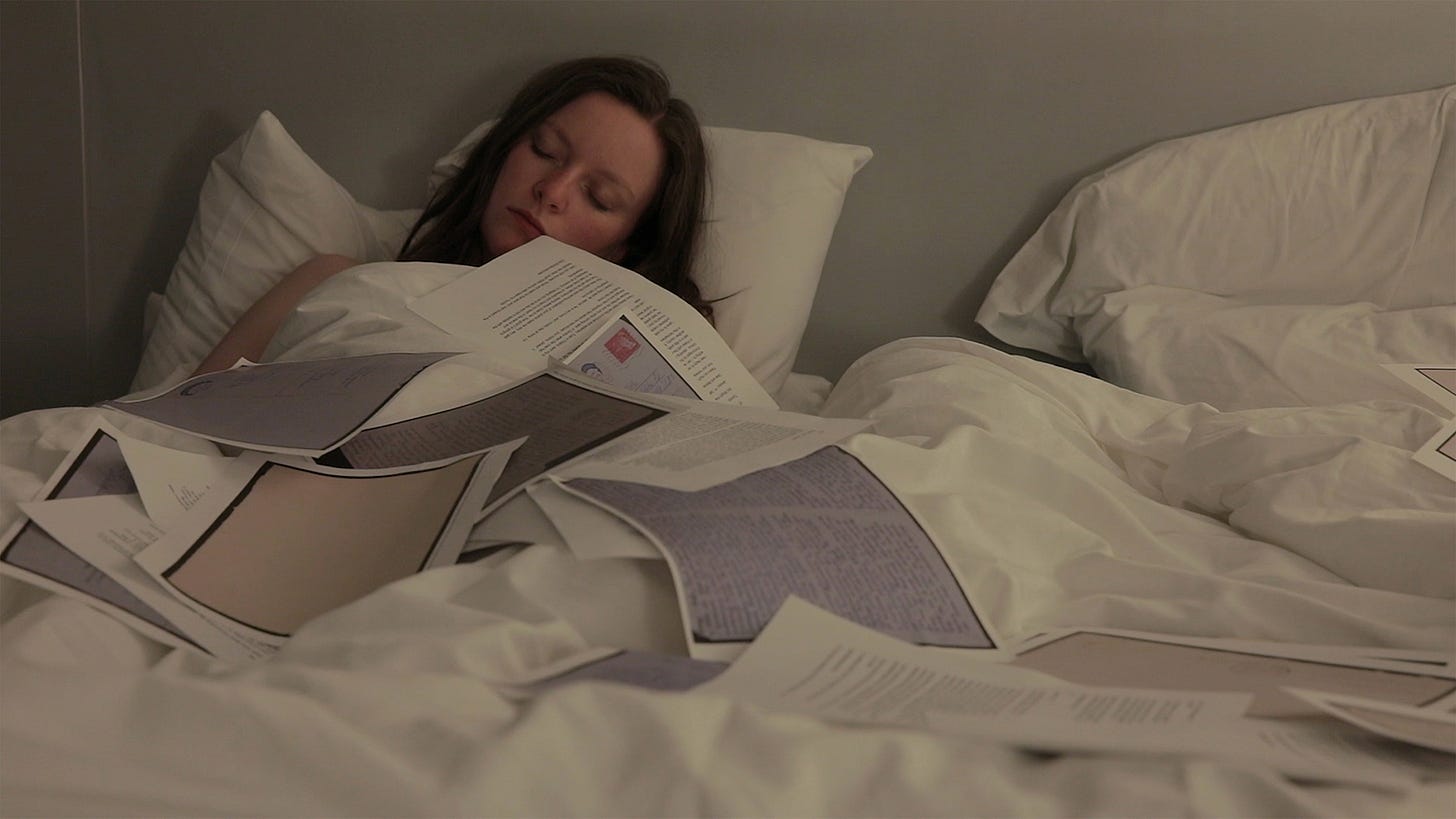MS Slavic 7 + Point and Line to Plane
Emily Jisoo Bowles on two films from Sofia Bohdanowicz’s Audrey project.
Welcome back to VOLUME 21: The Creative Nonfiction Film Weekend 2025.
Today, British-Korean film critic and programmer Emily Jisoo Bowles introduces ideas of art, translation, and family history in two hybrid films by Sofia Bohdanowicz and Deragh Campbell.
Taken in isolation, the final imagery of MS Slavic 7 might paint a rather romantic portrait of archival work: a woman is asleep surrounded by photocopied sheets strewn about her, so infatuated with her research that she cannot bear to part with it. Audrey (Deragh Campbell) is studying her great-grandmother’s letters, the Polish poet Zofia Bohdanowiczowa. As the literary executor of the estate, she legally owns these letters but cannot take them out of the library, the barriers she faces accruing throughout the film to refute anything idyllic about the last scene. Based on filmmaker Sofia Bohdanowicz’s own family history and featuring her great-grandmother’s real letters, the narrative unfolds as sparse, elliptical sequences of contemplation and frustration, tracing the uneasy gap between interpretation and projection.
As a recurring character in co-directors Campbell and Bohdanowicz’s collaborations, Audrey is an amalgamation of their creative sensibilities, her iterative selves probing their relationship to their own art as well as that of others. The film’s title refers to the library call number of the letters, situating them as archival objects mired in institutional red tape, an impersonal and arbitrary categorisation that stands in sharp contrast to the great affection and intensity of emotion contained within. ‘There’s something kind of horrifyingly raw... about seeing the actual physical objects,’ says Audrey, and there’s a rawness too in how she tries to articulate her feelings about them in semi-improvised monologues punctuated by long pauses and cracks in voice. She analyses the letters, drawing on theory and art references but never quite reaching a stable conclusion, sometimes straying further and further away from their actual content. In their short film Point and Line to Plane, Audrey grieves her friend through their shared love of Kandinsky, locating the mole on his nose in the painter’s circles. She is the intrepid researcher who seeks meaning in everything, grasping towards her own subjective truths to the point of hallucinating in front of a painting.
If art is a spiritual medium to communicate with the dead in Point and Line to Plane, the letters of MS Slavic 7 seem more akin to taxidermy, reflecting Audrey’s obsessive framing of the letters as objects. The Bach adagio that swells as she prepares to go to the library cuts to silent reverence as she examines the letters in a specialised room, stamped envelopes fetishised in clinical close-ups. Perhaps her inability to comprehend Polish is what emphasises the letters’ objecthood to her: paragraphs of poetic ramblings are just squiggly lines when you don’t know the language. But Audrey also has an ulterior motive: she wants to exhibit the letters in a gallery, to turn them into art objects. ‘You’re trying to make a business out of our family history!’ screeches her aunt, and there’s notably no mention of whether Zofia Bohdanowiczowa wanted anyone to read her letters, let alone have them displayed to the public. Ethical questions are elided in service to Audrey’s personal quandaries.
In a 2020 interview for Reverse Shot, Bohdanowicz explains that her filmography is built upon the need to explore her family history as a means to understand her identity and situate herself. So what does she want her great-grandmother’s letters to say about her? Audrey might be the legal owner of the letters but that doesn’t bring her any closer to knowing Zofia Bohdanowiczowa. Perhaps the more interesting question the film poses is not ‘does she have the right to use the letters?’ but rather ‘will she be able to do something worthwhile with them?’ Her aunt’s absurd rant that you need a master’s degree to curate an exhibition thus can be understood less as institutional endorsement, and more as a realisation that research takes dedicated time and labour. Having a famous Polish poet as a great-grandmother does not automatically make you a skilled interpreter of her work.
The letters, when they are not sacred objects to be exhibited, flash briefly on screen as fragmented subtitles. Their sparing presence of the letters’ content might speak to the kind of minimalist formalism the film is going for, but more obviously it emphasises the relative insignificance of these words compared to Audrey’s reception of them. There is little room in the film for anything that isn’t Audrey. Solipsism is momentarily eschewed by the appearance of the letters’ translator (Mariusz Sibiga), who brings her attention back to their emotional core: ‘I wouldn’t get hung up on structures, it’s the content that’s more… the narrative of affection and love is throughout all these letters,’ he tells her. None of her work would be possible without the work of the translator, mirroring how Audrey herself is a collaborative construct. By building on their multiverse of Audreys, Campbell and Bohdanowicz attempt to better understand themselves as artists, addressing the baggage of entitlement, self-doubt, and failure that comes with it. If filmmaking and research are a labour of love, it’s a collective one, where you need others to hold you accountable and remind you of what really matters.



